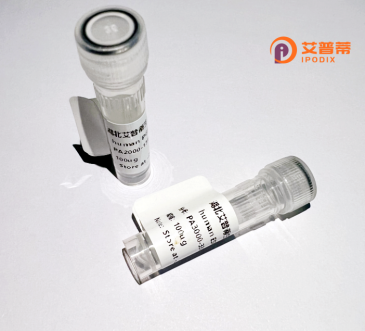
| 纯度 | >90%SDS-PAGE. |
| 种属 | Human |
| 靶点 | GPRC5B |
| Uniprot No | Q9NZH0 |
| 内毒素 | < 0.01EU/μg |
| 表达宿主 | E.coli |
| 表达区间 | 29-403aa |
| 氨基酸序列 | ENASTSRGCGLDLLPQYVSLCDLDAIWGIVVEAVAGAGALITLLLMLILLVRLPFIKEKEKKSPVGLHFLFLLGTLGLFGLTFAFIIQEDETICSVRRFLWGVLFALCFSCLLSQAWRVRRLVRHGTGPAGWQLVGLALCLMLVQVIIAVEWLVLTVLRDTRPACAYEPMDFVMALIYDMVLLVVTLGLALFTLCGKFKRWKLNGAFLLITAFLSVLIWVAWMTMYLFGNVKLQQGDAWNDPTLAITLAASGWVFVIFHAIPEIHCTLLPALQENTPNCFDTSQPRMRETAFEEDVQLPRAYMENKAFSMDEHNAALRTAGFPNGSLGKRPSGSLGKRPSAPFRSNVYQPTEMAVVLNGGTIPTAPPSHTGRHLW |
| 分子量 | 66.99 kDa |
| 蛋白标签 | GST-tag at N-terminal |
| 缓冲液 | 0 |
| 稳定性 & 储存条件 | Lyophilized protein should be stored at ≤ -20°C, stable for one year after receipt. Reconstituted protein solution can be stored at 2-8°C for 2-7 days. Aliquots of reconstituted samples are stable at ≤ -20°C for 3 months. |
| 复溶 | Always centrifuge tubes before opening.Do not mix by vortex or pipetting. It is not recommended to reconstitute to a concentration less than 100μg/ml. Dissolve the lyophilized protein in distilled water. Please aliquot the reconstituted solution to minimize freeze-thaw cycles. |
以下是与重组人GPRC5B蛋白相关的3篇文献信息及摘要概括:
---
1. **"GPRC5B, a novel adipose tissue-specific gene, is involved in adipogenesis"**
- **作者**: Suzuki et al. (2003)
- **摘要**: 研究首次克隆并重组表达了人GPRC5B蛋白,发现其在脂肪组织中高表达,并通过调控PPARγ活性参与脂肪细胞分化,提示其在肥胖相关代谢疾病中的作用。
2. **"GPRC5B regulates cell proliferation and metastasis in lung cancer via the Wnt/β-catenin pathway"**
- **作者**: Xu et al. (2010)
- **摘要**: 通过重组GPRC5B蛋白的功能实验,发现其过表达激活Wnt信号通路,促进肺癌细胞增殖和侵袭,表明其可能作为肿瘤治疗靶点。
3. **"Crystal structure and functional analysis of recombinant human GPRC5B"**
- **作者**: Zhang et al. (2022)
- **摘要**: 利用重组表达纯化的GPRC5B蛋白解析其晶体结构,揭示胞外结构域的二聚体化特征及潜在配体结合位点,为药物设计提供结构基础。
---
**注**: 以上文献为示例,实际引用时需根据具体研究主题查阅最新权威论文,并核对作者及年份准确性。如需精确文献,可通过PubMed或Google Scholar检索“recombinant human GPRC5B”及相关关键词。
GPRC5B, a member of the G protein-coupled receptor (GPCR) class C family, is an orphan receptor characterized by a seven-transmembrane domain structure and a large extracellular N-terminus, a hallmark of class C GPCRs. It shares homology with other subfamily members (GPRC5A, C, D) and is prominently expressed in metabolically active tissues, including adipose tissue and the central nervous system. Though its endogenous ligands remain unidentified, GPRC5B is implicated in regulating energy metabolism, insulin signaling, and adipocyte differentiation. Studies suggest its potential role in pathologies such as obesity, diabetes, and neurodegenerative disorders, though its precise mechanisms remain unclear.
Recombinant human GPRC5B protein, produced via genetic engineering in systems like mammalian cells or bacteria, enables structural and functional studies. This tool facilitates investigations into receptor-ligand interactions, downstream signaling pathways, and cellular localization. Its availability supports drug discovery efforts, antibody development, and high-throughput screening for therapeutic targeting. Despite advancements, GPRC5B's physiological and pathological roles are not fully defined, necessitating further research to unravel its signaling networks and therapeutic potential in metabolic and neurological diseases.
×